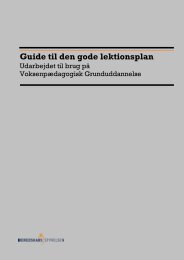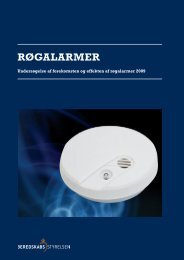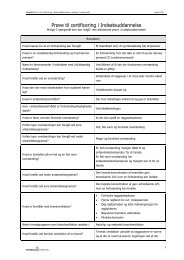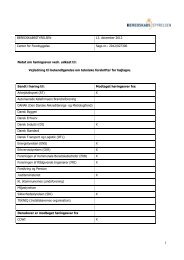<strong>Comprehensive</strong> <strong>Preparedness</strong> <strong>Planning</strong>consequences of incidents that do occur? Preventive measures will often work in the interestof reducing both probability and consequences.When choosing the risks that are unacceptable for the organisation, focus must primarily bedirected towards the relatively rare but potentially most serious individual incidents. More commonlyoccurring incidents must also be considered, however, if they collectively result in unacceptableconsequenceswhen added over acertain period. Manyorganisations live withrisks that they mightbe able to reducerelatively easily, butwhich they nonethelessaccept becausethe risks, when viewedseparately, are not perceivedas particularlydangerous.4.2 How can the incidents be prevented?When considering which initiatives will be most effective vis-à-vis the incidents that have beensingled out as warranting preventive efforts, these may be chosen within two general categories:••Physical measures•• Influencing behaviourPhysical measuresThis technical-oriented category of prevention serves the purpose of protecting or makingfacilities, systems, equipment, etc., more resilient. There exist a wide range of measures withvarying characteristics to choose from. Physical measures can, for instance, be:••Directed at preventing one specific type of incident (e.g. smoke detectors and fire doors) ordirected towards several types of incidents simultaneously.••Automated (e.g. standby power generators and back-up servers) or require human action.••Used in a stand-alone or combined manner. For example, protecting an installation againstunauthorised access can be achieved via physical barriers (fences, gates, locks, guards, etc.)as well as electronic security (alarm systems, surveillance cameras, etc.).Prevention by means of physical measures is often regulated by legislation, directives, technicalcodes, etc., and in certain areas it is subject to frequent control (e.g. fire inspections, health andsafety inspections, foodstuffs control). In such circumstances, each organisation may considerif it is in its own interest to adopt even more extensive preventive measures than those that aremade mandatory by authorities. In addition, there is a need for close collaboration betweenorganisational units in order to ensure a coherent prevention strategy, e.g. among local governmentdepartments which administer different laws and regulations.16
PreventionInfluencing behaviourThis type of prevention is directed at building, maintaining, or changing people’s knowledgeand attitudes – and though that – their behaviour. An important intermediate aim is to strengtheneach person’s own ability to prevent or react appropriately to undesirable incidents.The target group can be the organisation’s own employees, external partners, clients, costumersor the general population. When the target group is the organisation’s own employees,training and exercises play an especially important role (cf. chapters 5 and 6). Two other means– both internally and in relation to the surrounding society – are rules and information activities.Only authorities may issue legally binding rules for the behaviour of companies and citizens.However, all organisations can lay down rules for their own employees’ behaviour in the workplace.This may for example include an IT security policy with rules concerning the use ofpasswords, administrator rights to networks, storage and sharing of sensitive data, etc.Information activities to influence behaviour can also take many forms, including for example:••Guides, reports, strategies, educational material, etc. Sector responsible authorities can forexample issue publications to guide other organisations in fulfilling the conditions stipulatedby legislation.••Purposeful prevention campaigns, for example workshops, teaching, TV and radio features,advertisements, competitions on the internet, local community meetings and other publicarrangements.••Publishing relevant preparedness information on the organisation’s webpage and intranet.Prevention through physical measures or influencing behaviour can both be resource intensiveand measurable results are difficult to obtain in the short run. When the organisation choosesbetween alternative initiatives in the area of prevention, it must therefore compare their costswith expectations of how well the initiatives in question will work. In cases where the organisationdue to practical, economic, or other reasons cannot or will not invest in prevention, it mustrely solely on capacities for operational emergency response. An alternative option can be totransfer risks by taking out insurance against incidents, but this is by no means always possibleand, in any case, insurance policies only cover purely financial consequences.4.3 How can prevention be integratedinto other planning?The prevention area of comprehensive preparedness planning must be viewed in close connectionwith the organisation’s planning for operational emergency response, which is furtherdescribed in the guide’s Chapter 8 on Crisis Management Plans.Prevention can drastically reduce the dependence on and costs of operational response capacities.On the other hand, the necessity of operational emergency response capacities illustratesthat incidents can never be completely avoided despite preventive measures. Hence, theorganisation’s preparations to manage incidents complement its work in the area of prevention.17
















